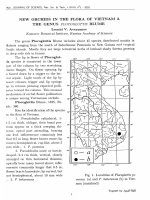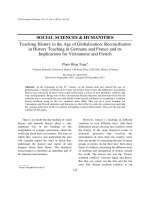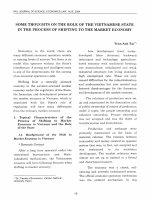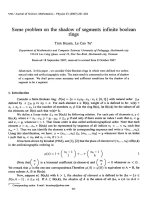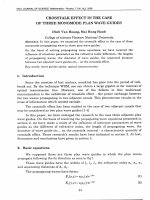DSpace at VNU: New technology for the production of biodiesel fuel
Bạn đang xem bản rút gọn của tài liệu. Xem và tải ngay bản đầy đủ của tài liệu tại đây (289.93 KB, 5 trang )
View Article Online / Journal Homepage / Table of Contents for this issue
Green Chemistry
Dynamic Article Links
Cite this: Green Chem., 2011, 13, 1124
www.rsc.org/greenchem
COMMUNICATION
Published on 22 March 2011. Downloaded by Anadolu University on 12/05/2014 10:16:49.
New technology for the production of biodiesel fuel†
Yasuaki Maeda,a Le Tu Thanh,a Kiyoshi Imamura,a Katsutoshi Izutani,a Kenji Okitsu,b Luu Van Boi,c
Pham Ngoc Lan,c Nguyen Cong Tuan,c Young Eok Yood and Norimichi Takenakab
Received 14th January 2011, Accepted 25th February 2011
DOI: 10.1039/c1gc15049a
A new, homogeneous method for producing biodiesel fuel
(BDF), achieving a minimum emission of waste and a low
consumption of energy, was developed by adding organic
solvents such as acetone to a reaction mixture of oil and
methanol with an alkaline catalyst. By adding acetone and
a smaller amount of catalyst at room temperature, fatty
acid methyl ester (FAME) was formed within 5 min with a
quality satisfying the international BDF standards, even in
the coexistent of water in the raw material. The difference
in the kinetic data when using isopropyl alcohol (IPA)
(all compounds are in a single phase) and acetone (all
compounds except glycerin are in a single phase), shows
that the retardation of FAME formation in the presence of
glycerin product is not due to the reverse reaction but to the
removal of methanol and KOH catalyst from the reaction
phase by the precipitated glycerin produced during the final
stages of the reaction.
The former Japanese Prime Minister Yukio Hatoyama declared
at the United Nations Summit on Climate Change in 2009
that Japan will aim to reduce CO2 emissions by 25% by 2020
compared with the 1990 level. The USA President Barack
Obama’s green dream team also declared that the USA will
be committed to battling climate change as one of the leaders
of reducing global warming. As alternatives to wind power
generation and solar batteries, biomass energy resources such
as methane, ethanol and BDF have attracted much attention for
the mitigation of global warming due to the carbon neutrality of
biomass. BDF production from vegetable oil is the most popular
because the formation process is faster and simpler than methane
or ethanol production. Therefore, more than 10 million tons of
BDF were produced in EU countries mainly from rape seed oil
a
Organization for Industry, University and Government Cooperation,
Osaka Prefecture University, 1–2 Gakuen-cho, Naka-ku, Sakai,
599-8531, (Japan). E-mail: ;
Fax: +81-72-254-9863; Tel: +81-72-254-9863
b
Graduate school of Engineering, Osaka Prefecture University, (Japan).
E-mail:
c
Viet Nam National University, Hanoi, (Vietnam)
d
Daegu University, (Korea)
† Electronic supplementary information (ESI) available. See DOI:
10.1039/c1gc15049a
1124 | Green Chem., 2011, 13, 1124–1128
and in the USA from soy bean oil in 2010, even though they
are edible oils.1 However, some questions remain: (1) What is
the best raw material available that does not increase food prices
or deforestation? (2) What is the best production method for
a green process by which fatty acid methyl ester (FAME) can
be obtained with a minimal emission of waste and low energy
consumption?
Many chemists have attempted to meet these requirements.2–7
One solution proposed to reduce the formation of soap with
an alkaline catalyst was the application of an enzyme catalyst,
but the reaction rate was too slow.8–10 Jordan and Gutsche11
have reported the simultaneous separation of glycerin with a
membrane. Aßmann et al.12 reported a two step reaction to
increase the yield of FAME with a smaller amount of methanol.
The BDF production from waste cooking oil by a conventional
mechanical stirring method requires the pretreatment of raw
material oil and the distillation of the final product to pass
the EU or USA standards of BDF. In 1960 Por´e, and in 1984
Freedman et al., reported the transesterification of vegetable oil
with methanol and described the reaction scheme as follows: 6
TG + CH3 OH
FAME + DG
(1)
DG + CH3 OH
FAME + MG
(2)
MG + CH3 OH
FAME + GL
(3)
where TG: triglyceride; DG: diglyceride; MG: monoglyceride;
and GL: glycerin. They also reported that the reaction rate
became slower after the formation of GL due to reverse reactions
of (1) to (3) and added excess amounts of methanol to oil (6 : 1
molar ratio) to accelerate the forward reactions. All subsequent
scientific papers followed the Freedman’s paper.13–15 However,
no one has confirmed the involvement of the reverse reactions.
In this paper, we have examined the reverse reactions and
found the decrease in the BDF production rate was not due to
the reverse reactions but to the elimination of the important
methanol reactant by its dissolution in GL. The reaction was
accelerated without heating, using small amounts of alkaline
catalyst, by adding a suitable co-solvent. Furthermore, the
separation of GL from FAME was accelerated in the presence
of acetone. Here, we report the development of a new, green
production method for BDF.
This journal is © The Royal Society of Chemistry 2011
View Article Online
Table 1 Dissolution of reactants and products in organic solvents (20 ◦ C)
Published on 22 March 2011. Downloaded by Anadolu University on 12/05/2014 10:16:49.
Solvents
Compounds
H2 O
CH3 OH
Acetone
THF
IPA
ANa
DE
FAME
TG
FAME
GL
CH3 OH
Oleic acidb , c
Stearic acidb , c
Soap
¥
¥
¥
¥
᭺
᭺
᭺
᭺
᭺
᭺
᭺
᭺
᭺
¥
᭺
᭺
᭺
᭺
᭺
᭺
᭺
᭺
᭺
¥
᭺
᭺
¥
¥
¥
¥
᭺
᭺
᭺
¥
᭺
᭺
᭺
᭺
¥
᭺
¥
᭺
¥
¥
¥
¥
¥
¥
¥
᭺
᭺
᭺
᭺
soluble,
᭺: was
◦
: slightly soluble, ¥: not soluble.a AN: acetonitrile. b FAME (methyl oleate). c Melting points of oleic acid and stearic acid are
16.3 C and 69.9 ◦ C, respectively.
How can we accelerate the formation of FAME in the reaction
between the immiscible oil and methanol? One approach is to
accelerate the reaction by heating and another is to accelerate
it by increasing the contact interface by forming small reactant
droplets through vigorous stirring by ultrasonic irradiation.16–19
Even so, the reaction can still only take place at the interface
between the immiscible reactants present in the heterogeneous
phases. If the FAME formation takes place in a homogeneous
phase, the reaction can be accelerated by a molecular-molecular
reaction. Boocock et al. 20 achieved acceleration of the FAME
formation by adding tetrahydrofuran (THF) or diethyl ether
(DE) but reported only that the reaction could be accelerated.
Therefore, we have studied the selection of the best solvent for
both formation and separation of FAME and elucidated the role
of solvents in FAME formation.
As shown in Table 1, methanol, TG and FAME were easily
dissolved in acetone or in THF, but GL was not. In contrast,
IPA dissolves all compounds related to the transesterification of
oil namely TG, FAME, GL, methanol and KOH catalyst. As
a result, the transesterification of oil with methanol to produce
FAME can be performed partially in the homogeneous phase
with acetone and THF until GL is formed and completely in the
homogeneous phase with IPA.
As shown in Fig. 1, the formation rate of FAME in acetone
is much faster than that without solvent and is the fastest
among the solvents with the addition of a 4.5 : 1 molar ratio of
methanol to oil. Moreover, the retardation of FAME formation
could be observed clearly in the heterogeneous system without
solvent. On the other hand, in the case of IPA, the reaction
occurred in the homogeneous system. As shown in Fig. 2a
and 2b, the formation rate with IPA was very fast even at
a 3 : 1 molar ratio of methanol addition. Furthermore, the
formation of FAME and consumption of methanol could reach
stoichiometric completion even with addition of 1 : 1, 2 : 1 and
3 : 1 molar ratios of methanol to oil in the homogeneous phase
with IPA. We concluded that there is no reverse reaction in the
homogeneous system. The formation of the fatty acid isopropyl
ester was only about 1% of the formation of methyl ester, due to
the steric hindrance of the isopropyl group. Therefore, the IPA
reaction is neglected in further discussion.
Why does the FAME formation reaction rate slow down
in the final stages of the reaction? Is it due to the reverse
reaction of the products to the original reactants, as proposed
by Freedman et al.? The reaction of methyl oleate, with GL,
This journal is © The Royal Society of Chemistry 2011
Fig. 1 Effect of solvent on the FAME yield. (᭛) acetone, ( ) IPA, ( )
THF, (¥) DE, (᭹) AN, (᭺) without solvent. Conditions: molar ratio
of methanol to canola oil, 4.5 : 1; solvent to oil, 25 wt%; KOH to oil,
0.5 wt%; temperature, 20 ◦ C.
monoolein, and diolein from 20 ◦ C to 60 ◦ C with and without
KOH catalyst has been studied to elucidate the reason for the
reaction retardation after GL formation. However, as shown in
Table 2, no reverse reaction could be observed, even after one
week. From this result, the retardation of FAME formation is
not due to the reverse reactions of equilibrium reactions (1)–(3)
and the retardation must occur through other phenomena.
From the results shown in Table 2 and Fig. 1 and 2, we have
concluded that the retardation of FAME formation after the
formation of GL can be explained as follows: in the case without
solvent, or with acetone or THF, GL cannot be dissolved in the
oil or FAME, but methanol and KOH catalyst dissolve well in
GL. Therefore, FAME formation is retarded after the formation
of GL due to the dissolution of the important reactant methanol
and the catalyst into the GL phase, which easily precipitates
and is excluded from the reactant solution. On the other hand,
FAME formation is not retarded and does not require excess
methanol in the presence of IPA, which forms a homogeneous
solution that includes GL, as shown in the supplementary data
photograph S1a.†
As described above, FAME could be effectively produced
by the co-solvent method with acetone or IPA. However, as
shown in the supplementary data photographs S1a and b,† the
separation of FAME from GL is completely different when using
Green Chem., 2011, 13, 1124–1128 | 1125
View Article Online
Table 2 Confirmation of the reverse reactions
Reactant
Published on 22 March 2011. Downloaded by Anadolu University on 12/05/2014 10:16:49.
GL
GL
MG
MG
DG
DG
FAME
FAME
FAME
FAME
FAME
FAME
Molar ratio
KOH wt%
Result
FAME/GL = 3
FAME/GL = 3
FAME/MG = 2
FAME/MG = 2
FAME/DG = 1
FAME/DG = 1
0.5
0.0
0.5
0.0
0.5
0.0
No formation of MG, DG, TG
No formation of MG, DG, TG
No formation of DG, TG
No formation of DG, TG
No formation of TG
No formation of TG
GL: glycerin, FAME: oleic acid methyl ester, MG: oleic acid mono-glyceride, DG: oleic acid di-glyceride. All results were obtained in the reaction
with both the co-solvent and conventional mechanical stirring method at 20–60 ◦ C for 168 h (7 days).
gravity and viscosity between the two phases. The specific
gravities and viscosities of FAME with the solvents is shown in
the supplementary data Table S1.† The specific gravities of the
GL phase were GL + methanol 1 : 3 (0.9870) < GL + methanol
1 : 1 (1.111) < neat GL (1.2632). Therefore, in the presence of
acetone, the difference in specific gravity between FAME in
acetone (0.8395) and GL with one mole of excess methanol
(1.111) is 0.2715. Due to the large difference in specific gravity
and small viscosities of the two components, GL was rapidly
separated from the FAME solution and precipitated within
30 min. On the other hand, with the conventional mechanical
stirring methods, scientists have used a methanol/oil ratio of 6.
Therefore, the separation of FAME from GL took a long time
because the difference in specific gravity between FAME and
GL was small, only 0.1077. (This calculation is based on the
assumption that an excess 3 moles of methanol are dissolved
in GL, for which the specific gravity is 0.9870, and the specific
gravity of neat FAME is 0.8793).
The effect of water on the formation of FAME is very
important when waste cooking oil was used as the raw material.
As shown in Fig. 3, the formation of FAME even in the presence
of 5 wt% of water was not retarded in the co-solvent method.
In contrast, the yield of FAME at 60 min became ca. 15% in
the presence of 5 wt% of water in the conventional mechanical
stirring method.
Fig. 2 a) Effect of methanol amount on the FAME yield and b) change
in methanol concentration (C 0 : concentration of methanol at time 0,
C t : concentration of methanol at time t). Conditions: molar ratio of
methanol to canola oil (᭛) 4 : 1, (᭺) 3 : 1, ( ) 2 : 1, ( ) 1 : 1; KOH to
oil, 0.5 wt%; co-solvent IPA to oil, 25 wt%; temperature, 20 ◦ C.
acetone or IPA. With acetone, which does not dissolve GL, the
separation of FAME from GL was very fast because of the
lower viscosity of the FAME-acetone solution and the large
difference between the low-density FAME-acetone solution and
GL. In contrast, with IPA, the solution was homogeneous even
after the formation of GL and the separation was not observed
as seen in the supplementary data photograph S1a.† However,
after the removal of IPA from the solution, GL and FAME were
completely separated.
Why can the separation of FAME from GL be accelerated
with acetone? The gravimetric separation can be accelerated
mainly through two factors which are the differences in specific
1126 | Green Chem., 2011, 13, 1124–1128
Fig. 3 The effect of water on the formation rate of FAME. (᭛) 2 wt%
water, co-solvent; ( ) 5 wt% water, co-solvent; ( ) 2 wt% water,
mechanical stirring; (᭺) 5 wt% water, mechanical stirring. Conditions:
molar ratio of methanol to waste cooking oil, 4.5 : 1; acetone to oil,
25 wt%; KOH to oil, 0.5 wt%; temperature, 20 ◦ C.
This journal is © The Royal Society of Chemistry 2011
View Article Online
Table 3 Properties of biodiesel produced from cat fish oil or Jatropha Curcas oil at pilot plant scale with a capacity of 300 L/batch under the
condition: molar ratio of methanol to oil, 4.5 : 1; acetone to oil, 25 wt%; KOH catalyst to oil, 0.5 wt%; temperature, 25 ◦ C
Published on 22 March 2011. Downloaded by Anadolu University on 12/05/2014 10:16:49.
Result (%)
JIS K2390
Test parameter
Unit
Cat fish
Jatropha
Min.
Max.
Test method
Total ester
MG
DG
TG
Free GL
Total GL
Acid value
Iodine value
Methanol
Water content
Mass (%)
Mass (%)
Mass (%)
Mass (%)
Mass (%)
Mass (%)
mg KOH g-1
g I2 /100 g
Mass (%)
mg kg-1
97.5
0.40
0.10
<0.01
<0.01
0.21
0.08
67.0
<0.1
380
97.8
0.56
<0.01
<0.01
<0.01
<0.24
<0.06
87.0
<0.1
450
96.5
—
—
—
—
—
—
—
—
—
—
0.80
0.20
0.20
0.02
0.25
0.5
120
0.20
500
EN 14103
EN 14105
EN 14105
EN 14105
EN 14105
EN 14105
JIS K2501
JIS K0070
EN 14110
JIS K2275
Notes: this table gives the certified quality of our biodiesel product analyzed by an authorized analysis organization, just for demonstrating its quality.
JIS: Japanese Industrial Standard for biodiesel and testing method. EN: European Standard for testing method.
Only addition of 0.02 wt% of KOH to oil was enough to
complete the BDF formation from canola oil which contained
less than 0.2 wt% of water by co-solvent method. On the
other hand, 0.5 wt% addition of KOH was needed from waste
cooking oil which contained about 2.0 wt% water. This result
showed that the stability of potassium methoxide, which might
be the working state of added KOH catalyst in the presence
of methanol in acetone, must be higher than that without
acetone.
The result from this study was applied to the production of
BDF from cat fish oil or Jatropha Curcas oil and the properties
of BDF produced were shown in Table 3.
The production of 300 L BDF from cat fish oil or Jatropha
Curcas oil by this pilot plant (reaction (10 min) → recovery of
acetone and excess methanol (30 min) → separation of crude
glycerin (30 min) → washing with water three times (20 min ¥ 3
= 60 min) → drying of BDF (30 min)) needed about three hours.
Experimental
Reaction: oil (40 g) and co-solvent (40, 20, or 10 g) were mixed
with methanol in a given molar ratio at room temperature
(20 ± 1 ◦ C or 25 ± 1 ◦ C) with different amounts of KOH
catalyst in a 100 mL Erlenmeyer flask. Acetone, THF, DE,
IPA, AN, ethyl acetate, 1,4-dioxane and dimethyl-sulfoxide were
examined as co-solvents that have been widely used as solvents
in organic reactions. However, the oil did not dissolve in ethyl
acetate, 1,4-dioxane or dimethyl-sulfoxide so no results are
given. The chemical compositions of oils used in this study
are shown in the supplementary data, Table S2.† One of either
GL, mono-oleate or di-oleate was mixed with the methyl ester
of oleic acid with or without KOH, and the production of
MG, DG and TG were determined to confirm the reverse
reactions.
Conclusions
The transesterification of vegetable oils and methanol in the
presence of KOH catalyst by using a co-solvent method shows
the following new results: the formation of FAME could be
completed even with addition of 4 mol methanol to 1 mol
This journal is © The Royal Society of Chemistry 2011
oil, KOH catalyst (0.1–0.5 wt% to oil) at room temperature
by adding acetone (25 wt% to oil). The formation of soap was
negligibly small, and as a result the separation rate of FAME
from the by-product GL was accelerated by more than 10 times
compared with the conventional mechanical stirring method.
The coexistent of less than 5 wt% water did not decrease the
yield of FAME and did not increase the formation of soap by
co-solvent method. Furthermore, excess amounts of methanol
and acetone in the BDF layer after phase separation were
simultaneously recovered by heating the BDF layer at 60 ◦ C
under reduce pressure, 0.1 atm, and they were used for the
next experiment. The retardation of FAME formation after
GL formation could be explained due to the elimination of
reactant methanol which is easily dissolved in the GL, but is
not due to the back reaction of the products. The co-solvent
method could be recognized as a new, green technology for the
production of renewable biomass energy because BDF could
be produced with minimum energy consumption and minimum
waste emission.
Acknowledgements
This study was supported by the New Energy and Industrial
Technology Development Organization and the Japan Science
and Technology Agency.
References
1 R. E. H. Sims, W. Mabee, J. N. Saddler and M. Taylor, Bioresour.
Technol., 2010, 101, 1570–1580.
2 G. W. Huber and A. Corma, Angew. Chem., Int. Ed., 2007, 46, 7184–
7201.
3 M. Verzui, B. Cojocaru, J. Hu, R. Richards, C. Ciuculescu, P. Filip
and V. I. Parvulescu, Green Chem., 2008, 10, 373–381.
4 J. A. Melero, J. Iglesias and G. Morales, Green Chem., 2009, 11,
1285–1308.
¨
5 M. Stocker,
Angew. Chem., Int. Ed., 2008, 47, 9200–9211.
6 J. Por´e, Ol´eagineux, 1960, 15, 65–172; B. Freedman, E. H Pryde
and T. L. Mounts, J. Am. Oil Chem. Soc., 1984, 61, 1638–
1643.
7 B. Freedman, R. O. Butterfield and E. H. Pryde, J. Am. Oil Chem.
Soc., 1986, 63, 1375–1380.
¨
¨
8 T. Stoveken
and A. Steinbuchel,
Angew. Chem., Int. Ed., 2008, 47,
3688–3694.
Green Chem., 2011, 13, 1124–1128 | 1127
Published on 22 March 2011. Downloaded by Anadolu University on 12/05/2014 10:16:49.
View Article Online
9 W. Du, L. Wang and D. Liu, Green Chem., 2007, 9, 173–
176.
10 Y. Watanabe, Y. Shimada, A. Sugihara and Y. Tominaga, J. Am.
Oil Chem. Soc., 2001, 78, 703–707; A Demirbas, Energy Convers.
Manage., 2008, 49, 2106–2116.
11 V. Jordan and B. Gutsche, Chemosphere, 2001, 43, 99–105.
12 G. Aßmann, G. Blasy, B. Gutsche, L. Jeromin, J. Rigal, R.
Armengaud and B. Cormary, EP 0494177, 1989 (Henkel).
13 R. Sawangkeaw, K. Bunyakiat and S. Ngamprasertsith, Green Chem.,
2007, 9, 679–685.
14 J. M. Marchetti, V. U. Miguel and A. F. Errazu, Renewable
Sustainable Energy Rev., 2007, 11, 1300–1311.
1128 | Green Chem., 2011, 13, 1124–1128
15 G. Vicente, M. Martinez and J. Aracil, Bioresour. Technol., 2004, 92,
297–305.
16 Y. Warabi, D. Kusudiana and S. Saka, Bioresour. Technol., 2004, 91,
283–287.
17 A. V. Bridgwater and G. V. C. Peacock, Renewable Sustainable Energy
Rev., 2000, 4, 1–73.
18 C. Stavarache, M. Vinatoru, R. Nishimura and Y. Maeda, Chem.
Lett., 2003, 32, 716–717.
19 L. T. Thanh, K. Okitsu, Y. Sadanaga, N. Takenaka, Y. Maeda and
H. Bandow, Bioresour. Technol., 2010, 101, 5394–5401.
20 D. G. B. Boocock, S. K. Konar, V. Mao, C. Lee and S. Buligan, J.
Am. Oil Chem. Soc., 1998, 75, 1167–1172.
This journal is © The Royal Society of Chemistry 2011
